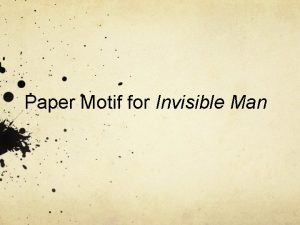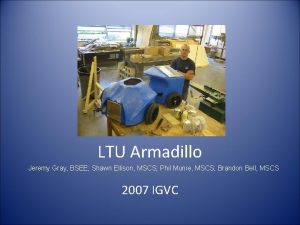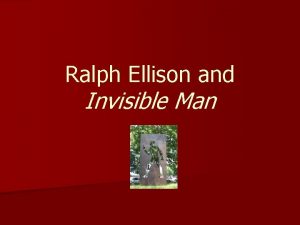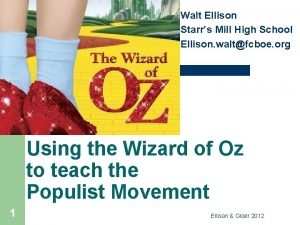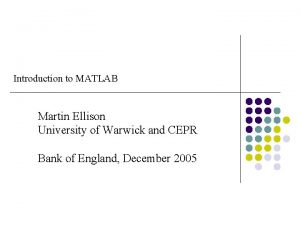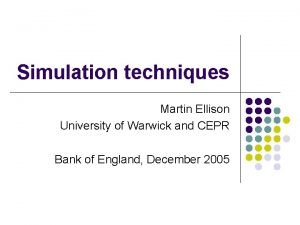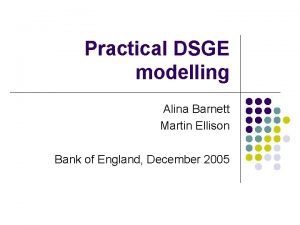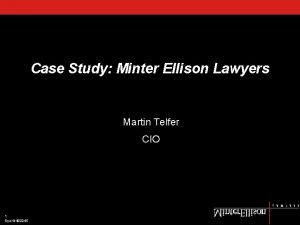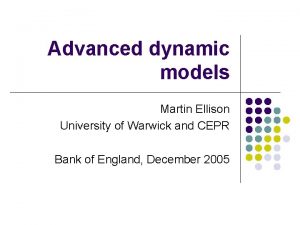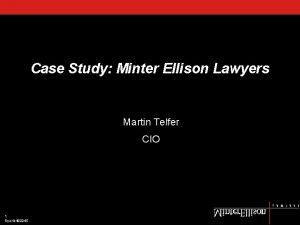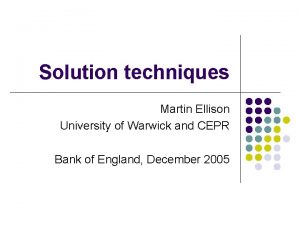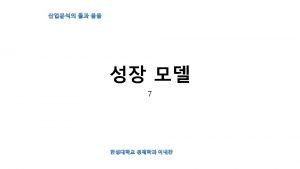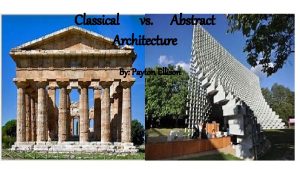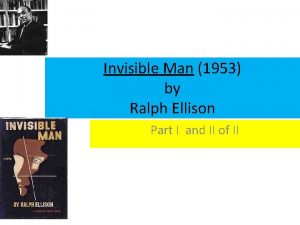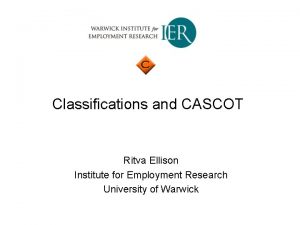Taking a model to the computer Martin Ellison
























- Slides: 24

Taking a model to the computer Martin Ellison University of Warwick and CEPR Bank of England, December 2005

Baseline DSGE model Monetary authority Firms Households

Households Two simplifying assumptions: CRRA utility function No capital

Dynamic IS curve Non-linear relationship Difficult for the computer to handle We need a simpler expression

Log-linear approximation Begin by taking logarithms of dynamic IS curve Problem is last term on right hand side

Properties of logarithms Taylor series expansion of logarithmic function To a first order (linear) approximation Applied to dynamic IS curve

Log-linearisation Log-linear expansion of dynamic IS curve (1) Steady-state values (more later) (2) (1) – (2)

Deviations from steady state What is ? percentage deviation of Zt from steady state Z In case of output, is output gap,

Log-linearised IS curve Slope = -σ

Advanced log-linearisation The dynamic IS curve was relatively easy to log -linearise For more complicated equations, need to apply following formula

Firms Previously solved for firm behaviour directly in log-linearised form. Original model is in Walsh (chapter 5).

Aggregate price level Original equation Log-linearised version

Optimal price setting Original equation Log-linearised version

Myopic price Original equation Log-linearised version

Marginal cost Original equation Log-linearised version

Wages Original equation Log-linearised version

Monetary authority We assumed Equivalent to Very similar to linear rule if it small

Log-linearised DSGE model Monetary authority Firms Households

Steady state Need to return to original equations to calculate steady-state Assume From household for monetary authority

Steady state calculation From firm

Full DSGE model

Alternative representation

State-space form Generalised state-space form Models of this form (generalised linear rational expectations models) can be solved relatively easily by computer

Next steps Derive a solution for log-linearised models Blanchard-Kahn technique
 Invisible man chapter 9
Invisible man chapter 9 Ellison g gray
Ellison g gray Hình ảnh bộ gõ cơ thể búng tay
Hình ảnh bộ gõ cơ thể búng tay Ng-html
Ng-html Bổ thể
Bổ thể Tỉ lệ cơ thể trẻ em
Tỉ lệ cơ thể trẻ em Chó sói
Chó sói Chụp phim tư thế worms-breton
Chụp phim tư thế worms-breton Hát lên người ơi alleluia
Hát lên người ơi alleluia Các môn thể thao bắt đầu bằng tiếng đua
Các môn thể thao bắt đầu bằng tiếng đua Thế nào là hệ số cao nhất
Thế nào là hệ số cao nhất Các châu lục và đại dương trên thế giới
Các châu lục và đại dương trên thế giới Công thức tiính động năng
Công thức tiính động năng Trời xanh đây là của chúng ta thể thơ
Trời xanh đây là của chúng ta thể thơ Cách giải mật thư tọa độ
Cách giải mật thư tọa độ 101012 bằng
101012 bằng Phản ứng thế ankan
Phản ứng thế ankan Các châu lục và đại dương trên thế giới
Các châu lục và đại dương trên thế giới Thể thơ truyền thống
Thể thơ truyền thống Quá trình desamine hóa có thể tạo ra
Quá trình desamine hóa có thể tạo ra Một số thể thơ truyền thống
Một số thể thơ truyền thống Cái miệng xinh xinh thế chỉ nói điều hay thôi
Cái miệng xinh xinh thế chỉ nói điều hay thôi Vẽ hình chiếu vuông góc của vật thể sau
Vẽ hình chiếu vuông góc của vật thể sau Biện pháp chống mỏi cơ
Biện pháp chống mỏi cơ đặc điểm cơ thể của người tối cổ
đặc điểm cơ thể của người tối cổ
